In a 1959 work, the Chilean neurophysiologist Humberto Maturana * with Lettvin and other colleagues published a curious article called “What the frog’s eye tells the frog’s brain” (Lettvin, 1959). In this work they were able to show that the frog does not represent reality as it create it, that is that the frog sees what it needs to see, for example, flies that are the basis of its diet that move quickly instead of other large and heavy animals . The frog is not concerned with the details of objects that are static or moving slowly, just only with objects that are sources of food. He doesn´t discover the existing reality, but creates it in the act of observation. Although in their work they clarify that yhe research is only applicable to the frog, it was the starting point for their studies on epistemology and with his student and later colleague Francisco Varela, gave life to the concept of autopoiesis (Maturana and Varela, 1973), according to which every living being is a closed system that is continually creating itself, and therefore repairing, maintaining and modifying itself.
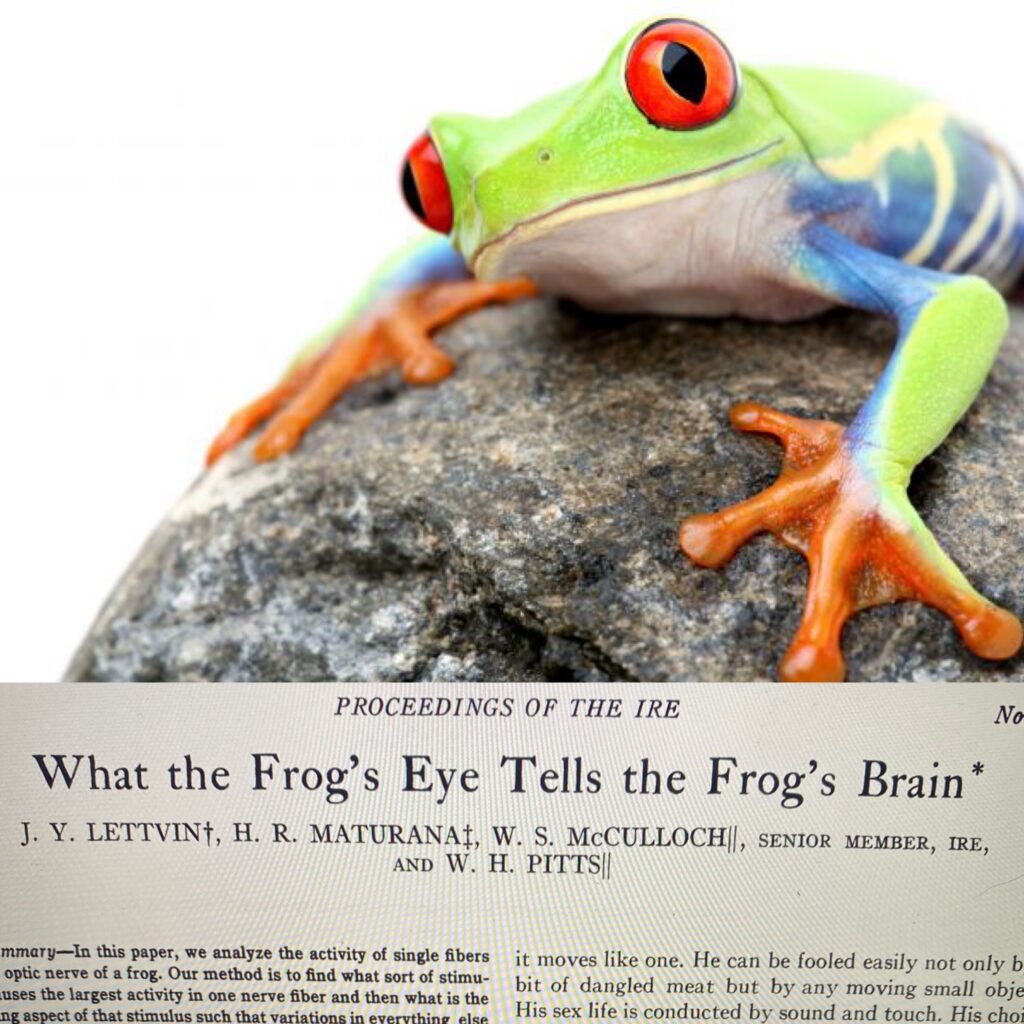
Like the frog itself, the observer does not discover the existing reality, but creates it on the spot, “we literally create the world we live in by living it.” Rejecting that Cartesian mind-body duality of understanding the world that is independent of the observer (Hustvedt, 2016). Reality is a product of the interaction between the observer and the system in which is part (environment). The real external world is part of the living system and cannot be shown to be external to it.
This notion has been widely treated from philosophy; at the end of the 19th century, the philosopher Henri Bergson in his book ¨Matter and memory¨ (book that in 1914 entered the ¨Index Librorum Prohibitorium¨ of the Catholic Church) postulated that the objects that surround the body reflect the possible action of the latter in the objects.
During the World war II, the psychologist James J. Gibson led a project on the effect that flying had on perception in pilots (visual identification of aircraft) that served to develop aptitude tests for pilots and laid the foundations for future studies. Influenced by the gestalt doctrine, through one of the main references in his training, the psychologist Koffka, with whom he shared the conviction that perception problems constitute the central problem of psychology. His studies led him to create a psychological theory, which he called ecological psychology. According to this theory, all the information to determine perception is in the environment. Both the environment and the organism are part of the same system that constantly feeds each other. Furthermore, the environment is what one perceives at a given moment.

His last book ¨The echological approach of visual perception¨ from 1979 proposes a detailed description of his ideas. The perception of the world is not as it can be perceived through the laws of physics, but through what the observer is capable of perceiving, so the dimensions range from millimeters to meters (such as objects that are capable of being perceived by the eye), atoms and large dimensions are not included. For Gibson the environment consists of everything that surrounds those organisms that perceive and behave, that is, animals. Both the observer and the environment are complementary, this exchange of information between both is functional, that is, significant and specific (Kelso and Engstrom, 2006).
According to this theory, perceiving an object, a chair, for example, does not consist in creating a visual image of a chair from the light stimulus, and then attributing those visual properties of the image to the chair itself; instead, what one sees are the visual properties of the chair.
In his book he incorporates the term affordances, which refers to the possibilities of action offered by the environment to act. They require that both the environment and the animal behave as a system. In the case of the chair mentioned above, one perceives the action of sitting and some other action offered by that element in the middle. Perception invites us to act.
The same for other situations, such as the front of a house that offers, among other things, the possibility of entering, surrounding it, or if you are a climber, you will perceive the possibilities of climbing it.
Some of these affordances are difficult to detect and requires some experience to be able to detect them. Different perceptions lead to different affordances, as is the case of the climber in the previous video who, in addition to perceiving the front of a house, perceives possibilities of climbing it. And this also works in reverse order, action changes perception (Hardgrove, 2019). When one learns a new skill, one begins to perceive affordances to put it into practice. With learning, experience, and knowledge, athletes skillfully tune in to the perceptual variables available in a performance environment to regulate the actions that enable them to overcome the task (Renshaw et al, 2019). Because perception and action are closely linked, the ability to grasp possibilities is also closely linked to the repertoire of movements that the athlete possesses.
One of the first studies related to climbing was carried out by Boschker et al (2002), where they evaluated the differences in perception between expert, entry-level and inexperienced climbers. In the first experiment they were asked to inspect a route for 2.5 minutes of 23 dams and reproduce their position and orientation, and in subsequent attempts they had periods of 5 seconds to observe and then correct the misplaced or oriented holds. , in the graph we can see according to the levels the average number of attempts in which they solved the task. In a second experiment with a small number of expert climbers and inexperienced climbers, they were asked to think aloud when memorizing the route, verbalizing everything they perceived. About a third of the reports from advanced climbers contained statements about the structure of the holds, while more than two-thirds contained information about the opportunities for climbing the holds, as opposed to the inexperienced who almost all of the the statements were only dedicated to the structure of the holds and not to their functionality. From both tests it can be deduced that expert climbers are capable of extracting more information from the specific climbing environment, focusing specifically on the functional aspects of the holds compared to those of intermediate level, and inexperienced ones.
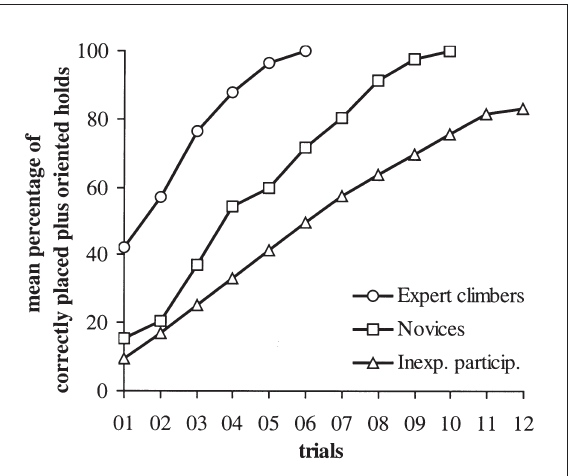
The biggest difference between the climbers levels is in how much information they are able to attend, and, therefore, the availability of opportunities for action (affordances) to be carried out (Orth et al, 2016). In the case of choosing to grab a hold with the right hand, convert the options of the other holds to be grabbed with the left hand, and other holds will be out of choice. At the same time, the need to reach a certain target hold (such as zone in a bouldering competition) determines what possibilities of action (affordances) they have retrospectively, and limits or excludes the possibilities of using other holds (Pezzulo et al., 2010).
During climbing information can be “nested” in such a way that the possibilities of action reflect the functional properties of the holds. Different climbing techniques require body positions in relation to the orientation, shape and position of the holds. They are opportunities that serve as a context for another. For example, the gripping capacity of a large hold can be nested within the traction capacity of the hold, and thus one category is built within the other, which would be an opportunity to acquire much more information. Such is the case of expert climbers who have the ability to remember a greater number of holds and their position, when relating them to the movements that are possible in the sequence.
A climber not only needs to reach and grab a hold, but he must also needs to control his body under the effects of gravity, in climbing reaching and grasping a hold is followed by a chain of successive actions. The climber must perceive the possibilities of reaching the hold, as well as using it to be able to move his body and grab the next hold (Seiffert et al, 2021).
In turn, affordances can be classified as action-scaled (in relation to action) or body-scaled (in relation to body size) (Fajen et al., 2009). The first are those possibilities to act that depend on the behavior of the individual, for example, how fast an individual moves in a particular place determines the possibilities to act. On the other hand, those related to the body scale are related to a particular dimension of the body and a particular environmental element.
In a recent study, Seiffert et al. (2021) investigated the perception of nested possibilities between conditions of varying complexity: touching a hold, grasping a hold, grasping a hold and remopve the other hand and grasping a hold and moving upward, in all cases as far as possible. Unsurprisingly, expert climbers accurately estimated their range and acted close to their maximum action capabilities, and when two or more nested affordances were used together (grasp and release and grasp and move up), the estimated maximum distance would appear to be better explained when scaled in relation to action (action-scaled) than when scaled in relation to body size (body-scaled), that is, the nested affordances invite experienced climbers to go a little further than they perceive in relation to their body dimensions.
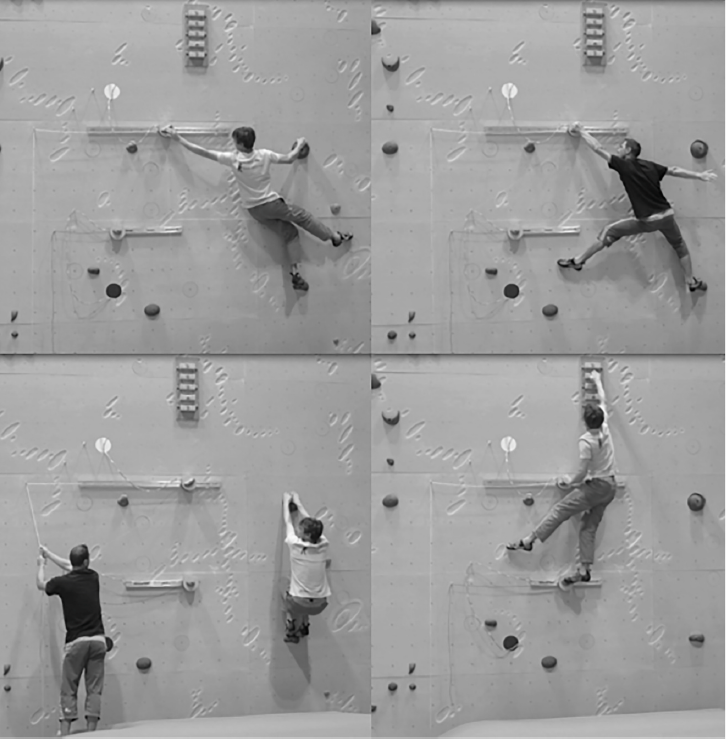
In another study carried out by Croft et al (2017) with children aged 6 to 11 years, they looked for the relationship between their own estimation of the reach of the arm to grasp a hold with the behavior when climbing. The boys who had better and more accurately perceived their reach, completed the proposed task of climbing diagonally with greater frequency and speed, mainly those who better judged their horizontal reach, and not so much their vertical or diagonal reach.
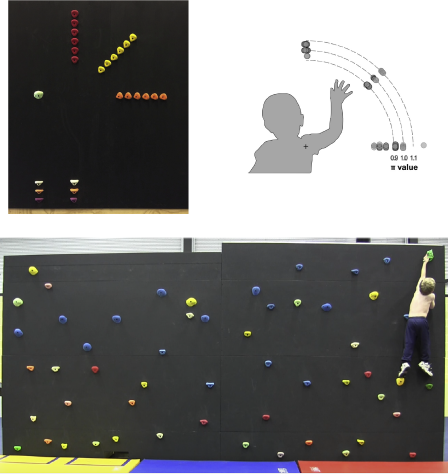
Skillful perception of the affordances is essential for efficient climbing. In indoor climbing we have the possibility of constantly modify the environment (moving the holds, volumes, etc.) to generate new possibilities of action and in this way provide a pedagogical opportunity that allows athletes to experience new situations, perceive new possibilities of action. . The acquisition of climbing skills through a model that incorporates the detection and use of relevant information from both the environment, the task and the organic conditions (see: complex dynamic systems in climbing) will provide a unique opportunity. to increase the experience of the climber and in this way obtain the maximum information at all times that will provide greater opportunities to efficiently resolve movements. The methodology called Constraints Led Approach originating from the works of Newell (1986) is an approach to teach based on the fundamental concept of individual-environment interdependence. Through the interaction of the three aforementioned categories (task, organism, medium) the student / athlete will self-organize in an attempt to generate an effective movement solution (Renshaw et al, 2019).
*While I was writing this article, Humberto Maturana Romesín, one of the most brilliant minds in Latin America, passed away.

References
Bergson, H. (2006). Materia y memoria. Buenos Aires, Editorial Cactus.
Boschker, M. S. J., Bakker, F. C., & Michaels, C. F. (2002). Memory for the functional characteristics of climbing walls: Perceiving affordances. Journal of Motor Behavior,34(1), 25–36.
Croft, J. L., Pepping, G.-J., Button, C., & Chow, J.-Y. (2018). Children’s perception of action boundaries and how it affects their climbing behavior. Journal of Experimental Child Psychology, 166, 134–146.
Fajen, B. R., Riley, M. A., & Turvey, M. T. (2009). Information, affordances, and the control of action in sport. International Journal of Sport Psychology, 40(1), 79–107.
Gibson, J. J. (1979). The ecological approach to visual perception. Boston: Houghton Mifflin.
Hargrove T. (2019). Playing with movement. Ed. Better Movement
Husvedt, Siri. (2016). Los espejismos de la certeza. Buenos Aires, Ed. Planeta, 2021
Kelso, J. A. S., & Engstrøm, D. A. (2006). The complementary nature. The MIT Press.
Lettvin J. Y., Maturana H. R., McCulloch W. S., and Pitts, W. H. (1959). What the Frog’s Eye Tells the Frog’s Brain. Proceedings of the IRE, vol. 47, no. 11, pp. 1940-1951, Nov. 1959
Maturana, H. y Varela, F. (1973), De máquinas y seres vivos: una teoría sobre la organización biológica. Santiago, Editorial Universidad de Chile.
Newell, K. M. (1986). Constraints on the Development of Coordination. In M. G. Wade, & H. T. A. Whiting (Eds.), Motor Development in Children: Aspects of Coordination and Control (pp. 341-360). The Netherlands: Martinus Nijhoff, Dordrecht.
Orth D., Button C., Davids K. (2016). What current research tells us about skill acquisition in climbing. En: The science and practice of climbing and mountaineering. Routledge
Pezzulo, G., Barca, L., Lamberti Bocconi, A., & Borghi, A. M. (2010). When affordances climb into your mind: Advantages of motor simulation in a memory task performed by novice and expert rock climbers. Brain and Cognition, 73, 68–73.
Renshaw, I., Davids, K., Newcombe, D., & Roberts, W. (2019). The Constraints-Led Approach: Principles for Sports Coaching and Practice Design (1st ed.). Routledge.
Seifert L., Dicks M., Wittmann F., Wolf P.(2021) The perception of nested affordances: An examination of expert climbers. Psychology of Sport and Exercise Volume 52, 2021, 101843, ISSN 1469-0292

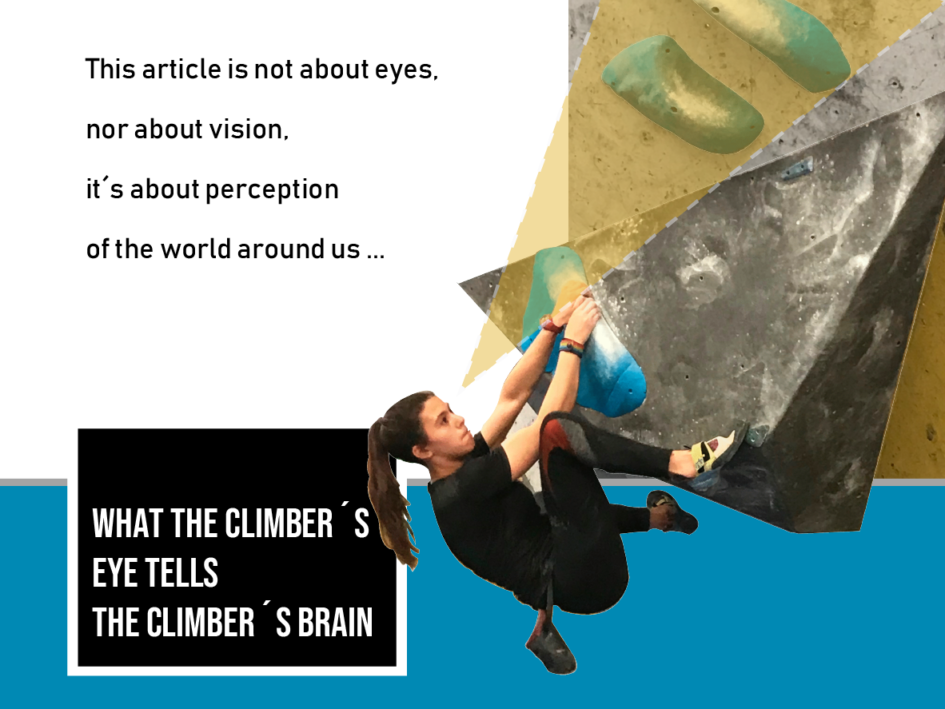
1 Pingback